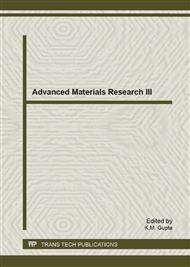p.240
p.245
p.250
p.259
p.264
p.271
p.277
p.285
p.290
The Role of Tool Pin Profile and Temperature on Friction Stir Welding of High Zinc Brass
Abstract:
In this experimental study, high zinc brass was welded by friction stir welding (FSW). A threaded cylindrical tool was used for welding the brass plates in butt configuration. Mechanical tests i.e. hardness, tensile, bending, and erichsen tests were performed for evaluating the welding strength. In addition, optical microscopy (OM) and scanning electron microscopy (SEM) were used as microstructural tests for estimating the material morphology. Furthermore, temperature as a function of time was measured during the welding. The results indicated close correlation between temperature and microhardness distribution as well as the uniformity of microstructure. Moreover, the welded sample showed acceptable mechanical strength during the applied mechanical tests due to adequate primary welding parameters and tool which led to sufficient produced temperature and material bonding.
Info:
Periodical:
Pages:
264-268
Citation:
Online since:
April 2013
Authors:
Price:
Сopyright:
© 2013 Trans Tech Publications Ltd. All Rights Reserved
Share:
Citation:


